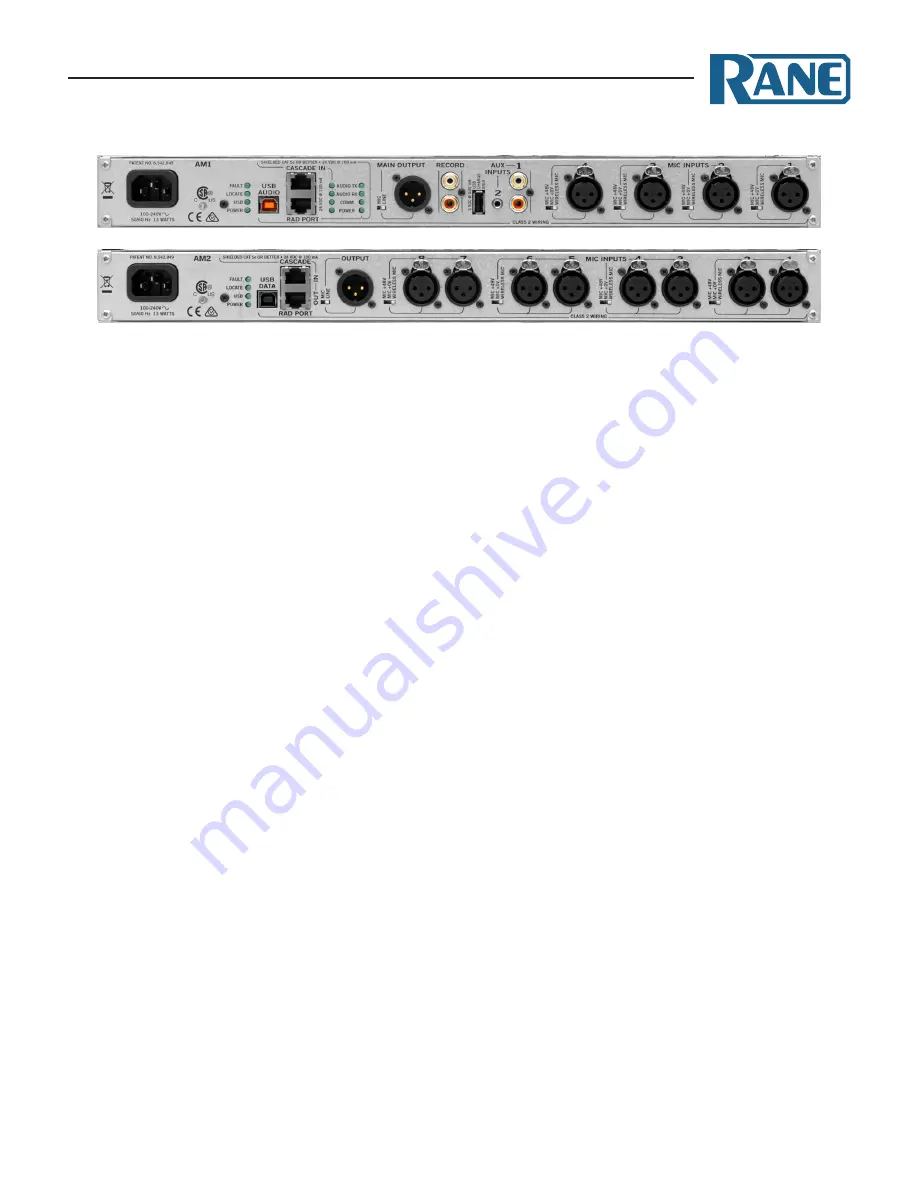
AM1 & AM2
AUTOMIXERS
Data Sheet - 2
AM1 and AM2 Common Features
The Rane AM1 and AM2 may be each be used on their own as a
standalone mixer, or add more gain-shared mics using up to seven
AM2 Automixers.
Each of the XLR Mic Inputs offers front panel input Level
controls feeding a gain-sharing automatic mixer. The AM1 has
four Mic Inputs, the AM2 has eight. Rear panel, 3-position
switches for each Mic Input support dynamic mics (no phantom
power), condenser mics (48 V), or wireless receiver outputs (+12
dBV max). A front panel Mic Mix Level control adjusts the vol-
ume of all automixed mics.
The Mic Inputs are optimized for automixing speech. They
have a fixed 80 Hz to 7 kHz bandpass filter (2nd-order Butter-
worth) to provide the best voice-only automatic mixing using a
gain-sharing algorithm.
Signal and Overload indicators monitor every Input Level
control and the Output Mix Level. Indicators flank each corre-
sponding Level control.
The XLR Main Output can be set to Mic- or Line-level to feed
a mic snake or a +20 dBu max balanced input. The front panel
Output Level control affects the XLR Output and the RAD Port
output.
AM2 mixers may be cascaded, but only one AM1 may be
used, and it must be the final unit in a chain of no more than
eight AMs. Simply connect Cascade OUT ports to Cascade IN
ports and the final Output level on the last AM controls the main
mono output mix.
Use the RAD Port to transport the main output mix digitally
via shielded CAT 5e to either a Rane HAL’s RAD Port for further
signal processing and control, or to a Mongoose for potential
routing to a CobraNet network.
Both the RAD and the Cascade IN port have status indicators
to aid setup and troubleshooting. Rear panel Fault, Locate, USB
and Power indicators inform head-scratchers of device errors, the
AM’s physical location, positive USB audio device OS registration
and AC power status. Duplicate Locate and Power indicators are
on the front and rear.
Universal IEC power on the rear supports 100 to 240 VAC
and 50/60 Hz.
AM1 Unique Features
The Rane AM1 is part gain-sharing automatic mic mixer, part
manual line mixer, part USB audio I/O device, and simultane-
ously a Rane RAD. Use it as a standalone mic/line mixer with
up to four mics, or add more gain-shared mics using up to seven
AM2 Automixers for up to 60 gain-shared mics.
Three manually-mixed audio inputs provide a simple user
interface and installation. The Aux 1 Input dual RCA and Aux 2
3.5 mm jacks are independently mono’ed, each with a front panel
Level control. A dedicated USB Charge port adjacent to Aux 2
provides power to USB devices such as iPods® or other USB-pow-
ered devices. The separate orange USB Audio Input also offers a
front panel Level control for the 16-bit, 48 kHz digital audio that
is mono’ed immediately upon entry.
The AM1 appears in Windows and Apple OS X computers
as a standard USB Audio Device, immediately compatible with
dozens of audio recording and playback audio applications. The
AM1 registers with the OS as a 16-bit 48 kHz device for both
incoming and outgoing audio. The USB Audio port doubles as a
firmware update port if future updates become available.
The front panel Output Level control affects the XLR Output
and the RAD Port output. The analog RECORD RCA Outputs
and the digital USB Audio output are both mono, pre-Output
Level, containing the same mix as the Main Output.
A front panel pre-Output Selector permits headphone cueing
so users can verify input and output operation before bringing
new sources into the live Output mix. Both ¼" & 3.5 mm head-
phone jacks with a Level control are provided.
AM2 Unique Features
The Rane AM2 is both an 8 channel, gain-sharing automatic mic
mixer and simultaneously a Rane RAD. Use it as a standalone
mic-only mixer, or add more gain-shared mics using up to seven
additional AM2 Automixers for up to 64 gain-shared mics.
When an AM2 is used standalone, both the XLR Output
and the RAD Port output audio are affected by the front panel
Output Level control. When the AM2’s Cascade Output feeds a
downstream Rane AM1 or AM2, the front panel Output Level
control only affects the XLR Output.
The USB port is solely used as a firmware update port if future
updates are needed.














































